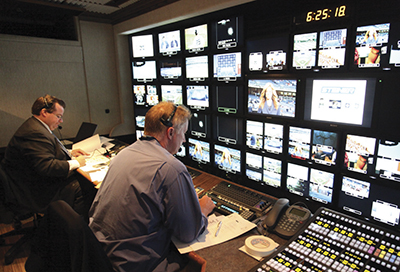From Bird’s-Eye to Panorama With YES View

NEW YORK—“What can we do differently?” That hypothetical question is always on the minds of directors, producers and camera personnel who are looking to bring a fresh perspective to a baseball broadcast, all in the spirit of innovation in their respective fields. And parks, of course.
That type of foresight is what the broadcast crew at YES Network, the regional sports carrier of the New York Yankees, feels that it’s been captured and presented: The net calls it “YES View,” a nine-camera system that creates a panoramic vision of a batter’s swing, a runner’s slide or a baseman’s sweeping tag.
Debuting in May during a broadcast of a game against the Oakland A’s, YES Network has teamed with Replay Technologies of Tel Aviv to bring this new dimension to the discerning fan base in the country’s number one media market.
IT’S A SETUP
The technical setup for YES View started with the installation of the nine fixed cameras (each weighing about 850 mg.) along the first base line. They’re mounted on the 200 level of Yankee Stadium, starting a dozen (or two) feet to the right of home plate that are somewhat evenly spaced to Section 205, near the right- field foul pole; one of those nine is mounted on the roof, in order to create depth to the look.
Speaking of innovation, Mike Webb, vice president of broadcast operations for YES, said that Replay Technologies is working to get 4K cameras to replace the original models already in use.

YES covers the Yankees out of the YES “Dynasty” truck, built by Game Creek in 2010. Currently they’re using Flare M 18-CLs from IO Industries in London Ontario, according to Jack Kestenbaum, director of technical operations for YES. “They look quite similar to digital single-lens reflex cameras in design and create 720p HD picture at 200 frames per second,” and are coupled with Canon lenses that range in depth from 85mm to 200 mm.
Each of the camera positions requires three single-mode fibers for transmission. The new Yankee Stadium (which is only four years old) already had considerable single-mode fiber in place within its infrastructure. “That prevented the need to have home runs installed for all nine of our camera positions,” said Kestenbaum.
The professional video industry's #1 source for news, trends and product and tech information. Sign up below.
While the effort of YES Network and Replay Technologies is novel, the technology is not brand new (it was used by the International Olympic Committee at the London 2012 Summer Olympics last year); still, the process has included much experimentation with equipment and lenses.
Another issue was that Replay Technologies operating staff had no baseball experience until a couple of months ago. “[Replay Technologies] came to us through their business development director, Mark Jeffers; they needed a platform in America,” said Webb. The companies are sharing costs, with Replay Technologies benefiting from the high-profile platform provided by the Yankees and the YES Network.
PROCESS REVEALED
The video magic coming from each camera location via those three single-mode fibers finds its way back down to the control point, which is located within the YES Network truck compound that sits just beyond the left field bleachers. Replay Technologies uses the Thinklogical CFL 4000 fiber link system to transmit the signals.
“At that point, each camera is linked to its own desktop-type computer; that’s also where another computer, called the ‘trigger,’ kicks off all nine of the desktop computers and directs them to capture” the images, Kestenbaum said.
An editor decides which camera sequence makes the best view and, on the fly, determines which makes the best replay of a given play. While YES Network opts to have one of its replay producers on hand in the compound, Replay Technologies personnel are “picking up the nuances of the sport very quickly,” he said.
THE NEXT STEP
As noted, this particular camera setup is new for baseball, but the system has been employed, albeit in markedly different venues. In addition to being used by the IOC in London to cover women’s gymnastics, Replay Technologies also used it at the number 5 tee at the 2012 Players Championship golf tournament.
YES Network began its foray into the use of the technology in March, tested its applications in April, and then brought it to air in early May. At that point is when the nine cameras and the software applications were calibrated.
Since then, great progress has been made. “It initially took more than two-and-one- half minutes to get video ready for air, which was way too long,” said Webb, “but once Replay Technologies had calibrated the system, the rendering time plummeted to 45 seconds.”
Initially, Kestenbaum said YES Network focused its content gathering on the goings- on at home plate, but before the end of the last June home stand, the system was reset to focus on first base. By then, the calibration process had improved to where it took under two minutes to get to air.
“We’re hoping to have that time drop as well,” he said. “We’re shooting for 45 seconds.”
“The amount of cooperation we received from the Yankees has been incredible,” Kestenbaum said, “because they see the value of YES View. The panoramic replay is just so unique.”
Mark R. Smith has covered the media industry for a variety of industry publications, with his articles for TV Technology often focusing on sports. He’s written numerous stories about all of the major U.S. sports leagues.
Based in the Baltimore-Washington area, the byline of Smith, who has also served as the long-time editor-in-chief for The Business Monthly, Columbia, Md., initially appeared in TV Technology and in another Futurenet publication, Mix, in the late ’90s. His work has also appeared in numerous other publications.

